Jedi, Jedi Knights, or collectively the Jedi Order are fictional characters, and often protagonists, featured in many works within the Star Wars franchise. Working symbiotically alongside the Old Galactic Republic, the Jedi Order is depicted as a religious, academic, meritocratic, and military (peacekeeping) organization whose origin dates back thousands of years before the events of the first film released in the franchise. The fictional organization has inspired a real-world new religious movement and parody religion: Jediism.
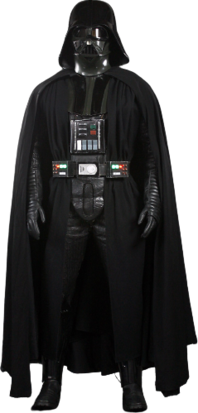
Darth Vader is a character in the Star Wars franchise. He is the primary antagonist of the original film trilogy and, as Anakin Skywalker, is the protagonist of the prequel trilogy. Born a slave on the planet Tatooine, he becomes a powerful Jedi. He is lured to the dark side of the Force by Chancellor Palpatine, and becomes the Sith Lord Darth Vader. After being severely wounded in a lightsaber battle, he is transformed into a cyborg. He is the husband of Padmé Amidala and the biological father of Luke Skywalker and Leia Organa Solo.

Star Wars: Episode III – Revenge of the Sith is a 2005 American epic space opera film that is the sequel to The Phantom Menace (1999) and Attack of the Clones (2002). It is the sixth film in the Star Wars film series, the third installment in the Star Wars prequel trilogy, and third chronological chapter of the "Skywalker Saga". It is written and directed by George Lucas, who also served as executive producer. The film stars Ewan McGregor, Natalie Portman, Hayden Christensen, Ian McDiarmid, Samuel L. Jackson, Christopher Lee, Anthony Daniels, Kenny Baker, and Frank Oz.
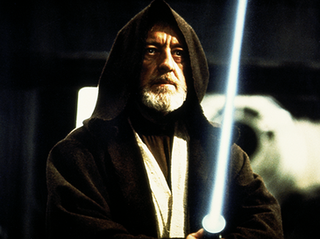
Obi-Wan Kenobi is a fictional character in the Star Wars franchise. Within the original trilogy, Obi-Wan is a Jedi Master as a supporting character and is portrayed by English actor Alec Guinness. In the later-released prequel trilogy, a younger version of the character serves as one of the two main protagonists, alongside Anakin Skywalker, and is portrayed by Scottish actor Ewan McGregor. In the original trilogy he is introduced as Ben Kenobi, an alias he uses while in hiding from the Empire. He is a mentor to Luke Skywalker, to whom he introduces the ways of the Jedi. After sacrificing himself in a duel against Darth Vader, Obi-Wan guides Luke through the Force in his fight against the Galactic Empire. In the prequel trilogy, set two decades earlier, he is initially a Padawan (apprentice) to Jedi Master Qui-Gon Jinn, and later mentor and friend of Luke's father Anakin, who falls to the dark side of the Force and becomes Vader. The character briefly appears in the sequel trilogy as a disembodied voice, speaking to protagonist Rey, and serving as the namesake of Ben Solo. He is frequently featured as a main character in various other Star Wars media, including the streaming television miniseries Obi-Wan Kenobi, in which McGregor reprised the role.

Count Dooku of Serenno, also known by his Sith name Darth Tyranus, is a fictional character in the Star Wars franchise, created by George Lucas. He is an antagonist in the Star Wars prequel trilogy, appearing in both Episode II – Attack of the Clones (2002) and Episode III – Revenge of the Sith (2005), played by Christopher Lee, as well as associated media, such as books, comics, video games, and television series. Actor Corey Burton has voiced Dooku in most of his animated and video game appearances, most notably Star Wars: Clone Wars (2003–2005), Star Wars: The Clone Wars, and the miniseries Tales of the Jedi (2022). Lee reprised the role in the 2008 animated film that launched The Clone Wars series.

The Galactic Empire, also known simply as the Empire, is a fictional autocracy featured in the Star Wars franchise. It was first introduced in the 1977 film Star Wars and appears in its two sequels: The Empire Strikes Back (1980) and Return of the Jedi (1983). It is the main antagonistic faction of the original trilogy. An oppressive, autocratic regime with a complicated bureaucracy, the Galactic Empire seeks to ensure singular rule and social control over every planet and civilization within the galaxy.

The Galactic Republic, commonly known as The Republic, is a fictional political entity in the Star Wars universe that predates the formation of the Galactic Empire. It is prominently featured in the prequel trilogy of Star Wars films, offering a glimpse into its history and functioning. In the original trilogy, which takes place after the events of the prequels, the Republic is referred to as the Old Republic, suggesting its long-established nature.
"The Imperial March (Darth Vader's Theme)" is a musical theme present in the Star Wars franchise. It was composed by John Williams for the film The Empire Strikes Back. Together with "Yoda's Theme", "The Imperial March" was premiered on April 29, 1980, three weeks before the opening of the film, on the occasion of John Williams' first concert as official conductor-in-residence of the Boston Pops Orchestra. One of the best known symphonic movie themes, it is used as a leitmotif throughout the Star Wars franchise.

General Grievous is a character in the Star Wars franchise created by George Lucas. He was introduced in the 2003 animated series Star Wars: Clone Wars, before appearing through computer-generated imagery in the 2005 live-action film Star Wars: Episode III – Revenge of the Sith. Wood reprised the role in the 2008 animated series Star Wars: The Clone Wars and the 2024 anthology Tales of the Empire.

Star Wars: Clone Wars is an American animated television series developed and directed by Genndy Tartakovsky and produced by Lucasfilm and Cartoon Network Studios for Cartoon Network. Set in the Star Wars universe, specifically between the Star Wars prequel trilogy films Attack of the Clones and Revenge of the Sith, it is amongst the first of many works to explore the Clone Wars. The show follows the actions of various prequel trilogy characters, notably Jedi and clone troopers, in their war against the droid armies of the Confederacy of Independent Systems and the Sith.
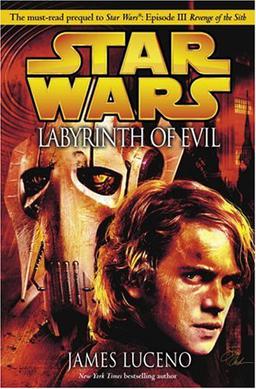
Star Wars: Labyrinth of Evil is a 2005 novel by James Luceno set in the fictional Star Wars universe. The novel serves as a lead-in to Star Wars: Episode III – Revenge of the Sith, and was loosely adapted into Volume Two of the Star Wars: Clone Wars microseries.
The Star Wars prequel trilogy, colloquially referred to as the prequels, is a series of epic space-opera films written and directed by George Lucas. It was produced by Lucasfilm Ltd. and distributed by 20th Century Fox. The trilogy was released from 1999 to 2005 and is set before the original Star Wars trilogy (1977–1983), chronologically making it the first act of the Skywalker Saga. Lucas had planned a prequel trilogy before the release of the original film, but halted major Star Wars films beyond the original trilogy by 1981. When computer-generated imagery (CGI) had advanced to the level he wanted for the visual effects he wanted for subsequent films, Lucas revived plans for the prequels by the early 1990s. The trilogy marked Lucas's return to directing after a 22-year hiatus following the original Star Wars film in 1977, as well as a 16-year hiatus between the classic and prequel trilogies.
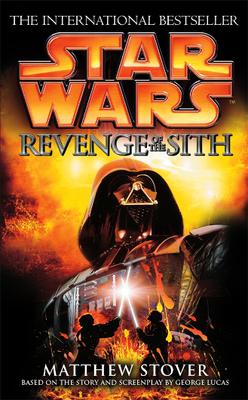
Star Wars: Revenge of the Sith is a novelization of the film of the same name, written by Matthew Stover and published on April 2, 2005, by Del Rey Books.

The Sith are the main antagonists of many works in the fictional universe of the Star Wars franchise. They are the antithesis and ancient enemies of the Jedi. The Sith Order is depicted as an ancient cult of warriors who draw strength from the dark side of the Force and use it to seize power by any means necessary, including terrorism and mass murder; their ultimate goals are to destroy the Jedi and rule the galaxy. The various antagonistic factions in the franchise, namely the Confederacy of Independent Systems, the First Galactic Empire, the Imperial Remnant and the First Order all originated, with the Sith. Sith, known individually as Sith Lords, are, by nature, ruthless. At any point a single individual assumes absolute authority amongst their kind and is granted the honorific Dark Lord of the Sith. Sith culture is based on perpetual treachery and betrayal. The fate of Sith Lords is, typically, to be murdered and replaced by their own apprentices. Sith teach their apprentices to revere the dark side of the Force, to give full reign to aggressive emotions such as rage and hatred, and to believe that others are expendable in the pursuit of power, it makes the Lords' demise inevitable.

Sheev Palpatine is a fictional character in the Star Wars franchise created by George Lucas. He first appears on screen in The Empire Strikes Back (1980), in which he is credited as The Emperor, and is the overarching antagonist of the three film trilogies in the Skywalker Saga, in which he is portrayed by Ian McDiarmid. The character is also known by his Sith name, Darth Sidious, which was first used in the novelization of The Phantom Menace (1999). In creating Palpatine, Lucas was inspired by real-world examples of democratic backsliding during the rise and rule of dictators such as Julius Caesar, Napoleon Bonaparte, and Adolf Hitler.
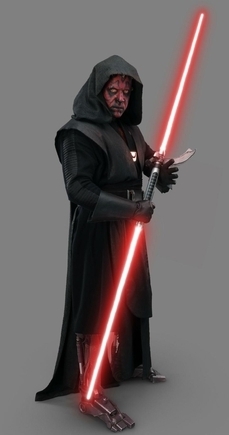
Darth Maul, later known simply as Maul, is a character in the Star Wars franchise. He first appeared in the 1999 film Star Wars: Episode I – The Phantom Menace as a powerful Sith Lord and Darth Sidious' first apprentice. Though seemingly killed by Obi-Wan Kenobi at the end of the film, Darth Maul returned in the 2008 animated series Star Wars: The Clone Wars. Star Wars creator George Lucas had intended for the resurrected Maul to serve as the main antagonist of the sequel film trilogy, but these plans were abandoned when Disney acquired Lucasfilm in 2012. The character nonetheless reappeared in the 2014 animated series Star Wars Rebels and the 2018 film Solo: A Star Wars Story, voiced again by Witwer; Park physically reprised the role in Solo. Since his initial defeat in The Phantom Menace, Maul has become an independent criminal mastermind and endured as Obi-Wan's archenemy.

Clone troopers are fictional characters from the Star Wars franchise created by George Lucas. First introduced in the live-action film Star Wars: Episode II – Attack of the Clones (2002), they have since appeared in various other Star Wars media, including Star Wars: Episode III – Revenge of the Sith (2005) and the animated series Star Wars: The Clone Wars, Star Wars Rebels (2014–2018), Star Wars: The Bad Batch (2021–present), and Tales of the Jedi (2022–present) as well as comics, novels, and video games set in both the Star Wars Legends expanded universe and the current canon.
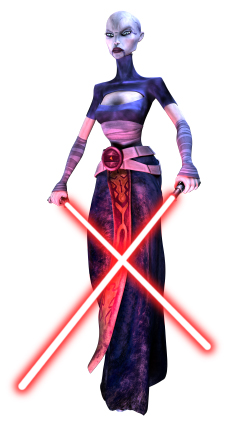
Asajj Ventress is a character from the Star Wars franchise. Originally intended to appear as an antagonist in the 2002 film Star Wars: Episode II – Attack of the Clones, she was first introduced in the 2003 micro-series Star Wars: Clone Wars, and is part of the Star Wars Legends continuity. A different version of Ventress was featured in the 2008 animated film The Clone Wars and the subsequent television series of the same name, in which she is voiced by Nika Futterman. The character also appears in tie-in Star Wars media such as books, comics, and video games, and has become a favorite among fans.

Mace Windu is a fictional character in the Star Wars franchise, portrayed by Samuel L. Jackson in the prequel trilogy. Jackson later reprised the role with voice only in the 2008 animated film Star Wars: The Clone Wars and the 2019 sequel film The Rise of Skywalker, whilst Terrence C. Carson voiced the character in other projects, such as The Clone Wars animated television series. The character also appears in various canon and non-canon Star Wars media like books, comics, and video games.
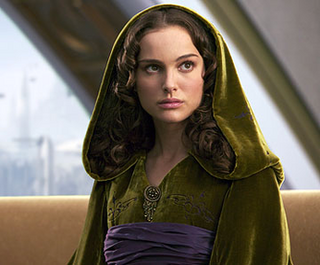
Padmé Amidala is a fictional character in the Star Wars franchise, appearing in the prequel trilogy and portrayed by Natalie Portman. First indirectly mentioned in Return of the Jedi, she is introduced in The Phantom Menace as the teenage Queen of Naboo, and after her reign, becomes a senator and an anti-war activist in the Galactic Senate. She secretly marries Anakin Skywalker, a Jedi Knight, then later dies while giving birth to twins Luke Skywalker and Leia Organa. Anakin's fear of losing Padmé serves as the catalyst in driving him to the dark side of the Force and becoming Darth Vader.

















